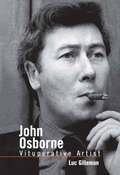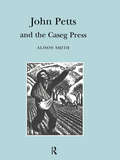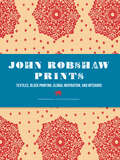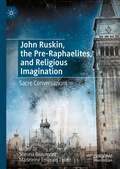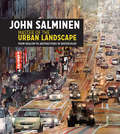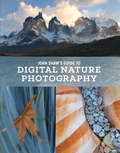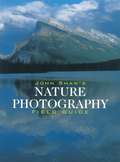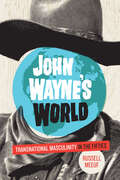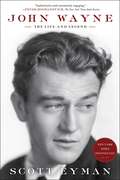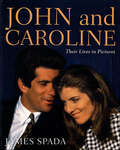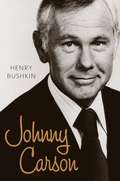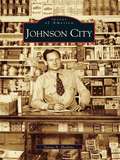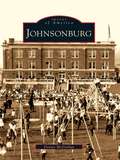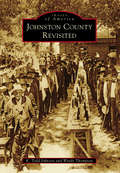- Table View
- List View
John Osborne: The Many Lives of the Angry Young Man
by John HeilpernJohn Osborne, the original Angry Young Man, shocked and transformed British theater in the 1950s with his play Look Back in Anger. This startling biography-the first to draw on the secret notebooks in which he recorded his anguish and depression-reveals the notorious rebel in all his heartrending complexity. Through a working-class childhood and five marriages, Osborne led a tumultuous life. An impossible father, he threw his teenage daughter out of the house and never spoke to her again. His last written words were "I have sinned." Theater critic John Heilpern's detailed portrait, including interviews with Osborne's daughter, scores of friends and enemies, and his alleged male lover, shows us a contradictory genius--an ogre with charm, a radical who hated change, and above all, a defiant individualist.
John Osborne: Vituperative Artist (Studies in Modern Drama)
by Luc GillemanFor British playwright, John Osborne, there are no brave causes; only people who muddle through life, who hurt, and are often hurt in return. This study deals with Osborne's complete oeuvre and critically examines its form and technique; the function of the gaze; its construction of gender; and the relationship between Osborne's life and work. Gilleman has also traced the evolution of Osborne's reception by turning to critical reviews at the beginning of each chapter.
John Paizs's Crime Wave
by Jonathan BallJohn Paizs's 'Crime Wave' examines the Winnipeg filmmaker's 1985 cult film as an important example of early postmodern cinema and as a significant precursor to subsequent postmodern blockbusters, including the much later Hollywood film Adaptation. Crime Wave's comic plot is simple: aspiring screenwriter Steven Penny, played by Paizs, finds himself able to write only the beginnings and endings of his scripts, but never (as he puts it) "the stuff in-between." Penny is the classic writer suffering from writer's block, but the viewer sees him as the (anti)hero in a film told through stylistic parody of 1940s and 50s B-movies, TV sitcoms, and educational films.In John Paizs's 'Crime Wave,' writer and filmmaker Jonathan Ball offers the first book-length study of this curious Canadian film, which self-consciously establishes itself simultaneously as following, but standing apart from, American cinematic and television conventions. Paizs's own story mirrors that of Steven Penny: both find themselves at once drawn to American culture and wanting to subvert its dominance. Exploring Paizs's postmodern aesthetic and his use of pastiche as a cinematic technique, Ball establishes Crime Wave as an overlooked but important cult classic.
John Petts and the Caseg Press (Routledge Revivals)
by Alison SmithThis title was first published in 2000: John Petts (1914-1991) is one of the outstanding wood-engravers of the twentieth century. His stunning prints featuring Welsh mountains and the people who live amongst them reflect his deep concern for the history of the land and are distinguished by his profound understanding of the physical and psychological properties of light. Extensively illustrated, John Petts and the Caseg Press spans the entire career of this reclusive artist and offers the first account of the private press he founded in Snowdonia in 1937. In 1935, John Petts and Brenda Chamberlain abandoned their studentships at the Royal Academy Schools, London for a rundown farmhouse in the rugged terrain of Snowdonia. They started the Caseg Press in 1937 in the hope that it might finance their freedom to work. At first dedicated to saleable ephemera such as Christmas cards and bookplates, the press later became involved in the broader Welsh cultural scene, providing illustrations for the Welsh Review, a monthly literary periodical. In 1941, with the writer Alun Lewis, the Caseg press produced a series of broadsheets designed to express continuity and identification with the life of rural Wales in the face of social change precipitated by the second world war. John Petts and the Caseg Press is the first monograph on this artist. It covers both his work for the Caseg Press and for other publishers such as the Golden Cockerel Press. The volume offers a unique insight into an important chapter in the history of private presses in Britain and the development of neo-romanticism in art and literature during the inter-war period.
John Robshaw Prints: Textiles, Block Printing, Global Inspiration, and Interiors
by John RobshawDesign enthusiasts and armchair travelers will love circling the globe with celebrated textile designer John Robshaw. From batiks in Java to ikats in Thailand and indigo printing in India, Robshaw reveals the lush inspiration behind his signature style while highlighting step-by-step block printing techniques from local artisans and masters. Robshaw provides a rare glimpse into his creative process, wherein he blends traditional methods with his own painterly style for entirely unique creations, and shares tips for incorporating textiles into any space. Brimming with beautiful photographs of covetable textiles, far-flung destinations, and eye-catching interiors, this luxe fabric-covered book is an eclectic visual tour of the rich tradition of textile printing.
John Ruskin and the Fabric of Architecture
by Anuradha ChatterjeeThrough the theoretical lenses of dress studies, gender, science, and visual studies, this volume analyses the impact John Ruskin has had on architecture throughout the nineteenth and twentieth centuries. It explores Ruskin’s different ideologies, such as the adorned wall veil, which were instrumental in bringing focus to structures that were previously unconsidered. John Ruskin and the Fabric of Architecture examines the ways in which Ruskin perceives the evolution of architecture through the idea that architecture is surface. The creative act in architecture, analogous to the divine act of creation, was viewed as a form of dressing. By adding highly aesthetic features to designs, taking inspiration from the 'veil' of women’s clothing, Ruskin believed that buildings could be transformed into meaningful architecture. This volume discusses the importance of Ruskin’s surface theory and the myth of feminine architecture, and additionally presents a competing theory of textile analogy in architecture based on morality and gender to counter Gottfried Semper’s historicist perspective. This book would be beneficial to students and academics of architectural history and theory, gender studies and visual studies who wish to delve into Ruskin’s theories and to further understand his capacity for thinking beyond the historical methods. The book will also be of interest to architectural practitioners, particularly Ruskin’s theory of surface architecture.
John Ruskin, the Pre-Raphaelites, and Religious Imagination: Sacre Conversazioni
by Sheona Beaumont Madeleine Emerald ThieleThis volume presents a collection of essays by leading experts which examine nineteenth century ideas about Christian theology, art, architecture, restoration, and curatorial practice. The volume unveils the importance of John Ruskin’s writing for today’s audience, and allies it with the dynamism of the Pre-Raphaelite religious imagination. Ruskin’s drawings and daguerreotypes, as well as Pre-Raphaelite paintings, stained glass, and engravings, are shown to be alive with visual theology: artists such as Dante Gabriel Rossetti, John Everett Millais, Edward Burne-Jones, and Evelyn de Morgan illuminate aspects of faith and aesthetics. The interdisciplinary nature of this volume encourages reflection upon praise, truth, and beauty. The aesthetic conversations between Ruskin and the Pre-Raphaelites themselves become a form of ‘sacra conversazione’.
John Ruskin: The Passionate Moralist
by Joan AbseJoan Abse treats Ruskin with deep and proper respect from start to finish; and she writes best of all on his ideas about art and artists.
John Salminen - Master of the Urban Landscape: From realism to abstractions in watercolor
by John SalminenTake a Journey with the Master of the Urban Landscape! John Salminen is one of the most accomplished watercolor artists working today, earning awards and recognition all over the world. Whether depicting the trees of Central Park, the architecture of San Francisco or the busy streets of Beijing, John Salminen's watercolor paintings are snapshots of urban life that are both rich in detail and universal in appeal. In Master of the Urban Landscape, Salminen shares over 150 pieces of his artwork, spanning his entire career. His early abstracts and recent plein air work in the book's Introduction set the groundwork for four chapters of remarkable watercolor paintings that highlight different aspects of his work: architectural form, organic form, human form and light and shadow. Throughout, Salminen shares the inspiration for his paintings, challenges he encountered and techniques he used to capture unique scenes from cities around the world. Embark on an amazing watercolor journey with John Salminen—Master of the Urban Landscape. "John Salminen is a master of the medium of watercolor. His sense of light and design sets him apart from his contemporaries, and he has emerged as one of the finest living artists of our times with a style very much his own." --Dean Mitchell
John Sargent
by The Hon. Sir Evan CharterisThe career of John Sargent, perhaps the greatest painter of his time, and surely one of the greatest portrayers and interpreters of it in his famous portraits of its most eminent and most representative figures, is here chronicled in successive stages.The figure of the hero stands out in high relief from the narrative which his personality pervades. A wealth of anecdote and of letters enriches the record of work, travel, and triumph, from student days under Carolus-Duran to the time when the presidency of the Royal Academy could have been his; and in all this opulent detail the character of the man overshadows even the distinction of the artist as the true theme of the book.
John Sayles (Contemporary Film Directors)
by David R. ShumwayJohn Sayles is the very paradigm of the contemporary independent filmmaker. By raising much of the funding for his films himself, Sayles functions more independently than most directors, and he has used his freedom to write and produce films with a distinctive personal style and often clearly expressed political positions. From The Return of the Secaucus Seven to Sunshine State, his films have consistently expressed progressive political positions on issues including race, gender, sexuality, class, and disability. In this study, David R. Shumway examines the defining characteristic of Sayles's cinema: its realism. Positing the filmmaker as a critical realist, Shumway explores Sayles's attention to narrative in critically acclaimed and popular films such as Matewan, Eight Men Out, Passion Fish, and Lone Star. The study also details the conditions under which Sayles's films have been produced, distributed, and exhibited, affecting the way in which these films have been understood and appreciated. In the process, Shumway presents Sayles as a teacher who tells historically accurate stories that invite audiences to consider the human world they all inhabit.
John Shaw's Guide to Digital Nature Photography
by John ShawPhotography legend John Shaw returns with his much-anticipated guide to digital nature photography, complete with more than 250 extraordinarily beautiful photographs. For over four decades, John Shaw&’s authentic voice and trusted advice has helped photographers achieve impressive shots in the great outdoors. In his first-ever book on digital photography, Shaw provides in-depth advice on everything from equipment and lenses to thorough coverage of digital topics including how to use the histogram. In addition, he offers inspirational and frank insight that goes far beyond the nuts and bolts of photography, explaining that successful photos come from having a vision, practicing, and then acquiring the equipment needed to accomplish the intention. Easily digestible and useful for every type of photographer, and complete with more than 250 jaw-dropping images, John Shaw&’s Guide to Digital Nature Photography is the one book you&’ll need to beautifully capture the world around you.
John Shaw's Nature Photography Field Guide
by John ShawAn updated bestseller, this book of extraordinarily beautiful photographs of nature contains state-of-the-art instruction on how any photographer can aim for equally impressive results every time a camera is focused on the great outdoors. Even highly skilled photographers are often baffled by the problems facing them when they work outdoors. But with this exceptional field guide in hand, every photographer--beginner, serious amateur, semi-pro, and pro--can conquer the problems encountered in the field. Using his own exceptional work as examples, the author discusses each type of nature subject and how to approach photographing it. Specific advice and information cover selection of equipment and lenses; how to compose a shot; how to get close ups; and other tips covering a range of techniques to enrich various types of nature photographs.From the Trade Paperback edition.
John Vassos: Industrial Design for Modern Life
by Danielle ShapiroWhat should a television look like? How should a dial on a radio feel to the touch? These were questions John Vassos asked when the Radio Corporation of America (RCA) asked him to design the first mass-produced television receiver, the TRK-12, which had its spectacular premier at the 1939 New York World&’s Fair. Vassos emigrated from Greece and arrived in the United States in 1918. His career spans the evolution of central forms of mass media in the twentieth century and offers a template for understanding their success. This is Vassos&’s legacy—shaping the way we interact with our media technologies. Other industrial designers may be more celebrated, but none were more focused on making radio and television attractive and accessible to millions of Americans.In John Vassos: Industrial Design for Modern Life, Danielle Shapiro is the first to examine the life and work of RCA&’s key consultant designer through the rise of radio and television and into the computer era. Vassos conceived a vision for the look of new technologies still with us today. A founder of the Industrial Designers Society of America, he was instrumental in the development of a self-conscious industrial design profession during the late 1920s and 1930s and into the postwar period. Drawing on unpublished records and correspondence, Shapiro creates a portrait of a designer whose early artistic work in books like Phobia and Contempo critiqued the commercialization of modern life but whose later design work sought to accommodate it.Replete with rich behind-the-product stories of America&’s design culture in the 1930s through the 1950s, this volume also chronicles the emergence of what was to become the nation&’s largest media company and provides a fascinating glimpse into its early corporate culture. In our current era of watching TV on an iPod or a smartphone, Shapiro stimulates broad discussions of the meaning of technological design for mass media in daily life.
John Walker's Passage
by Darrell VargaJohn Walker is one of Canada's most prolific and important documentary filmmakers and is known for his many thoughtful, personally inflected films. His masterwork, Passage, centres on Sir John Franklin's failed expedition to find the final link of the Northwest Passage connecting the Atlantic and Pacific oceans through the Canadian Arctic. It also gives us the story of John Rae, the Scottish explorer who discovered the fate of Franklin and the final link in the passage, but was left to the margins of history. Walker's film brings to this story a layering of dramatic action and behind-the-scenes documentary footage that build tension between the story of the past and interpretations of the present.Darrell Varga provides a close analysis of Passage, situating it within Walker's rich body of work and the Canadian documentary tradition. Varga illuminates how the film can be viewed through the lens of Harold Innis's theories of communication and culture, opening up the work of this great Canadian political economist to film studies.
John Wayne's World: Transnational Masculinity in the Fifties
by Russell MeeufThis cultural study examines the significance of John Wayne as a global symbol of masculinity in the mid-twentieth century. In a film career that spanned five decades, John Wayne became a US icon of heroic individualism and rugged masculinity. His widespread popularity, however, was not limited to the United States: he was beloved among moviegoers in Asia, Africa, Latin America, and Europe. In John Wayne&’s World, Russell Meeuf considers the actor&’s global popularity and makes the case that Wayne&’s depictions of masculinity in his most popular films of the 1950s reflected the social disruptions of global capitalism and modernization during that time. John Wayne&’s World places the actor at the center of gender- and nation-based ideologies, opening a dialogue between film history, gender studies, political and economic history, and popular culture. Moving chronologically, Meeuf provides new readings of the films Fort Apache, Red River, Hondo, The Searchers, Rio Bravo, and The Alamo and connects Wayne&’s characters with a modern image of masculinity taking shape after World War II. Considering Wayne&’s international productions, such as Legend of the Lost and The Barbarian and the Geisha, Meeuf shows how they resonated with US ideological positions about Africa and Asia. Meeuf concludes that, in his later films, Wayne&’s image shifted to one of grandfatherly nostalgia for the past, as his earlier brand of heroic masculinity became incompatible with the changing world of the 1960s and 1970s.
John Wayne: A Photographic Celebration
by Marc MompointJohn Wayne's name is synonymous with not only the tough cowboys of the Wild West, but also the all-American war hero. Rising beyond the standard recognition that most Hollywood actors get, Wayne achieved an unparalleled level of success as a walking and talking symbol of America. John Wayne: A Photographic Celebrationcollects many photographs from his long and celebrated career. Annotated with quotes from the man himself, as well as quotes about him from his loved ones, this book follows the course of his career from his breakthrough role in Stagecoach to his Oscar-winning performance in True Grit.One of the few conservative republicans in Hollywood during his time, John Wayne was a controversial figure. He was often meticulous about his image, believing that his status as a patriotic icon was a responsibility.Beautiful full-color photos will offer insight to this larger-than-life actor, both behind the scenes and in front of the camera. This book will delight both the casual and die-hard John Wayne fan, as well as anyone with a love for Westerns and war films.
John Wayne: The Life and Legend
by Scott EymanThe New York Times bestselling biography of John Wayne: &“authoritative and enormously engaging…Eyman takes you through Wayne&’s life, his death, and his legend in a detailed, remarkably knowledgeable yet extremely readable way&” (Peter Bogdanovich, The New York Times Book Review).John Wayne died more than thirty years ago, but he remains one of today’s five favorite movie stars. The celebrated Hollywood icon comes fully to life in this complex portrait by noted film historian and master biographer Scott Eyman. Exploring Wayne’s early life with a difficult mother and a feckless father, “Eyman gets at the details that the bean-counters and myth-spinners miss…Wayne’s intimates have told things here that they’ve never told anyone else” (Los Angeles Times). Eyman makes startling connections to Wayne’s later days as an anti-Communist conservative, his stormy marriages to Latina women, and his notorious—and surprisingly long-lived—passionate affair with Marlene Dietrich. He also draws on the actor’s own business records and, of course, his storied film career. “We all think we know John Wayne, in part because he seemed to be playing himself in movie after movie. Yet as Eyman carefully lays out, ‘John Wayne’ was an invention, a persona created layer by layer by an ambitious young actor” (The Washington Post). This is the most nuanced and sympathetic portrait available of the man who became a symbol of his country at mid-century, a cultural icon and quintessential American male against whom other screen heroes are still compared.
John and Caroline: Their Lives in Pictures
by James SpadaThey were America's children, symbolic of hope and youth, then of tragedy, and finally of the enduring power of the Kennedy legacy. In the 255 vibrant photographs in this book - mostly never before published - we watch John and Caroline grow up in the adoring, and sometimes harsh, glare of public attention.They were the youngest children to live in the White House in over a century - Caroline just three and John Jr. a newborn when their father took the oath of office. Symbolizing the youthful vigor of the new administration, they won the hearts of the American people as they romped around - and under - their father's desk in the Oval Office. And when, three years later, Caroline kissed JKF's coffin and John Jr. saluted the passing bier, they were forever etched into the nations' collective heart.We see their awkward adolescence, their sorrows at senseless losses in the family, their first forays into romance, their efforts to establish themselves as responsible adults, their happy marriages and Caroline's motherhood. And we watch in admiration as Caroline recovers from the untimely death of her beloved brother to assume the mantle of the Camelot legend.This is a book that will tug at the heart-strings of all who remember fondly these two remarkable American offspring.
Johnnie To Kei-Fung's PTU
by Michael InghamPTU is an underappreciated noir masterpiece by one of Hong Kong's most prolific and commercially successful directors. Johnnie To Kei-fung has been called "the poet of post-1997 and the economic savior of the Hong Kong film industry" for an extraordinary range of films produced during some of Hong Kong cinema's most difficult years. While many of To's celebrated films such as Election, Exiled and The Mission feature themes of criminal glory and revenge, PTU centers on the ethical dilemmas, personal dramas and stoic teamwork in the elite Police Tactical Unit. The story follows the PTU's all-night search for an officer's missing gun as they navigate triad turf struggles and marauding jewel thieves from mainland China. Shot over several years in the hauntingly empty pre-dawn streets of Tsim Sha Tsui, and released coincidentally amid the 2003 SARS panic, the film evokes Hong Kong's post-handover economic despair and multiple identity crises. In terms of character development and psychological complexity, Mike Ingham argues that PTU is the most aesthetically rigorous and satisfying of To's many films.
Johnny Carson
by Henry BushkinFrom 1962 until 1992, Johnny Carson hosted The Tonight Show and permeated the American consciousness. In the ’70s and ’80s he was the country’s highest-paid entertainer and its most enigmatic. He was notoriously inscrutable, as mercurial (and sometimes cruel) off-camera as he was charming and hilarious onstage. During the apex of his reign, Carson’s longtime lawyer and best friend was Henry Bushkin, who now shows us Johnny Carson with a breathtaking clarity and depth that nobody else could. From the moment in 1970 when Carson hired Bushkin (who was just twenty-seven) until the moment eighteen years later when they parted ways, the author witnessed and often took part in a string of escapades that still retain their power to surprise and fascinate us. One of Bushkin’s first assignments was helping Carson break into a posh Manhattan apartment to gather evidence of his wife’s infidelity. More than once, Bushkin helped his client avoid entanglements with the mob. Of course, Carson’s adventures weren't all so sordid. He hosted Ronald Reagan’s inaugural concert as a favor to the new president, and he prevented a drunken Dean Martin from appearing onstage that evening. Carson socialized with Frank Sinatra, Jack Lemmon, Jimmy Stewart, Kirk Douglas, and dozens of other boldface names who populate this atmospheric and propulsive chronicle of the King of Late Night and his world. But this memoir isn't just dishy. It is a tautly rendered and remarkably nuanced portrait of Carson, revealing not only how he truly was, but why. Bushkin explains why Carson, a voracious (and very talented) womanizer, felt he always had to be married; why he loathed small talk even as he excelled at it; why he couldn't visit his son in the hospital and wouldn't attend his mother’s funeral; and much more. Bushkin’s account is by turns shocking, poignant, and uproarious — written with a novelist’s eye for detail, a screenwriter’s ear for dialogue, and a knack for comic timing that Carson himself would relish. Johnny Carson unveils not only the hidden Carson, but also the raucous, star-studded world he ruled.
Johnny Carson
by Henry BushkinA revealing and incisive account of the King of Late Night at the height of his fame and power, by his lawyer, wingman, fixer, and closest confidantFrom 1962 until 1992, Johnny Carson hosted The Tonight Show and permeated the American consciousness. In the '70s and '80s he was the country's highest-paid entertainer and its most enigmatic. He was notoriously inscrutable, as mercurial (and sometimes cruel) off-camera as he was charming and hilarious onstage. During the apex of his reign, Carson's longtime lawyer and best friend was Henry Bushkin, who now shows us Johnny Carson with a breathtaking clarity and depth that nobody else could.From the moment in 1970 when Carson hired Bushkin (who was just twenty-seven) until the moment eighteen years later when they parted ways, the author witnessed and often took part in a string of escapades that still retain their power to surprise and fascinate us. One of Bushkin's first assignments was helping Carson break into a posh Manhattan apartment to gather evidence of his wife's infidelity. More than once, Bushkin helped his client avoid entanglements with the mob. Of course, Carson's adventures weren't all so sordid. He hosted Ronald Reagan's inaugural concert as a favor to the new president, and he prevented a drunken Dean Martin from appearing onstage that evening. Carson socialized with Frank Sinatra, Jack Lemmon, Jimmy Stewart, Kirk Douglas, and dozens of other boldface names who populate this atmospheric and propulsive chronicle of the King of Late Night and his world.But this memoir isn't just dishy. It is a tautly rendered and remarkably nuanced portrait of Carson, revealing not only how he truly was, but why. Bushkin explains why Carson, a voracious (and very talented) womanizer, felt he always had to be married; why he loathed small talk even as he excelled at it; why he couldn't visit his son in the hospital and wouldn't attend his mother's funeral; and much more. Bushkin's account is by turns shocking, poignant, and uproarious -- written with a novelist's eye for detail, a screenwriter's ear for dialogue, and a knack for comic timing that Carson himself would relish. Johnny Carson unveils not only the hidden Carson, but also the raucous, star-studded world he ruled.
Johnson City (Images of America)
by Sonya A. HaskinsThe Johnson City area was originally settled in 1777 by pioneers from North Carolina with land grants. Dissatisfied with their representation in North Carolina, local citizens held a convention and formed the state of Franklin in 1784. This state was never recognized by Congress. It fizzled out in 1788, and Tennessee was formed in 1796. More settlers came to the new state, but the area was destined to grow into a city when a combination of railroad connections in the area sparked growth during the late 19th century. In 1903, the creation of the National Soldiers Home brought disabledveterans of the Spanish-American War and the Civil War to Johnson City. Readers of this book will enjoy viewing photographs and reading about early residents, prominent homes, and historic buildings such as the East Tennessee Normal School, which opened in 1911. Many of the more than 200 photographs in this volume have never beforebeen published.
Johnsonburg (Images of America)
by Dennis McgeehanJohnsonburg, the "Paper City," is situated at the juncture of the east and west branches of the Clarion River in Pennsylvania's Allegheny Mountains. Its prime location guaranteed that this vibrant community in Elk County would flourish. Surrounded by trees, Johnsonburg made a living from wood. Sawmills, tanneries, and a large paper mill have dominated the lives of the Italian immigrants and other groups that settled in town. River transportation gave way to railroads, and Johnsonburg became a hub of rail carriers moving freight and passengers. Its riverside location also had disadvantages, and the history of the community is measured in flood years. Johnsonburg was frequently flooded, but the people never gave in to hard times. Today Johnsonburg is still mostly surrounded by trees, and the forests have made the area a sporting paradise. Hunting, fishing, and outdoor recreation are an important part of the modern economy.
Johnston County Revisited
by K. Todd Johnson Windy ThompsonCreated in 1746, Johnston County is located along the fall line between North Carolina's Piedmont and Coastal Plain regions. Smithfield, on the Neuse River, has been the county seat since 1771. In 1856, Johnston County became part of the Fertile Crescent along the east-west North Carolina Railroad, which spawned the thriving towns of Princeton, Pine Level, Selma, and Clayton. In the 1880s, a north-south rail line, eventually known as the Atlantic Coastline, brought Kenly, Micro, Four Oaks, and Benson into existence. Johnston County boasts film legend Ava Gardner, bootleg kingpin Percy Flowers, Vicks VapoRub, and other local claims to fame. It is still a farming county, although recent growth from the Research Triangle region has brought marked changes to the rural landscape. In recent years, Wilson's Mills and Archer Lodge have gained corporate status. These historical images tell a story not only of the extraordinary people who have called Johnston County home but also of the ordinary, everyday individuals who have left their mark.

